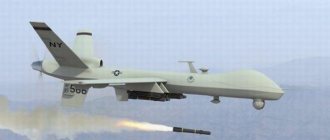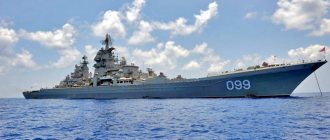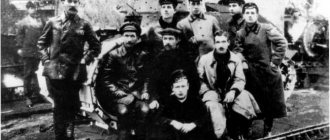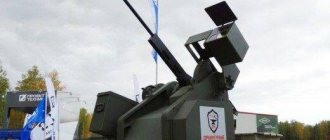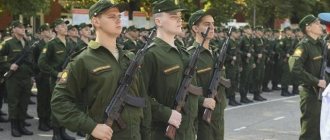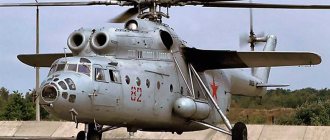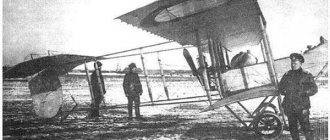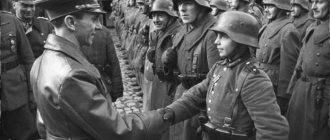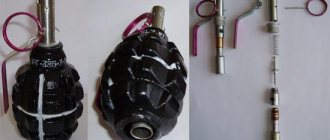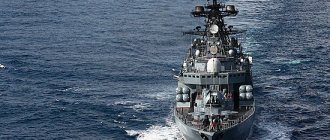Below is a list of the Commanders-in-Chief of the USSR and Russian Air Forces in the post-war period. For a list of commanders of the air force of the Red Army of the USSR from 1918 to 1946, see here. To complete the picture, you can find out where it all began: lists of the Chiefs of the Air Force of the Russian Empire and the chiefs of the air fleet of the White Armies during the Civil War. To complete the picture, I also recommend material about the leadership of the air defense forces.
***
Chief Marshal of Aviation VERSHININ Konstantin Andreevich [21.05 (3.06).1900 - 30.12.1973]
Commander-in-Chief of the Air Force (04/1946 - 07/1949 and 01/1957 - 03/1969).
Soviet military leader, air chief marshal (1959), Hero of the Soviet Union (08/19/1944).
In military service since 1919. Graduated from infantry command courses (1920), the Higher Tactical Rifle School of the Red Army Command Staff (Vystrel courses, 1923), the Red Army Air Force Academy named after. prof. N.E. Zhukovsky (1932), Kachin Military Pilot School (extern, 1935).
Participant of the Civil War in Russia: Red Army soldier, commander of a marching company of a reserve regiment. After the war, he commanded a training company of the 12th Red Banner Infantry Course of the Volga Military District (1923-1928), a rifle battalion (1928-1930). Since 1930, as part of the Air Force of the Red Army: head of the operational department of the headquarters of the aviation brigade (from 06.1932), assistant head of the tactical department of the Research Institute of the Red Army Air Force (from 06.1933), squadron commander of the highest flight tactical courses of the Red Army (from 02.1934) , assistant chief for flight training (since 1938), chief of the higher aviation advanced training courses for flight personnel of the Red Army (since 05.1941).
During the Great Patriotic War: commander of the Air Force of the Southern Front (09-1941-05.1942), 4th Air Army (05-09.1942; 05.1943-1945), Air Force of the Transcaucasian Front (09.1942-04.1943). He was distinguished by his deep knowledge in the field of operational art, constant search for new things, and a creative approach to solving assigned problems. This allowed him to skillfully organize the interaction of air force formations with ground forces and provide effective assistance to combined arms and tank armies.
In the post-war period: Commander-in-Chief of the Air Force (1946-1949), at the same time Deputy Minister of the Armed Forces of the USSR. He made a great contribution to the re-equipment of military aviation with jet aircraft. Since 1950, he again commanded the air army, and from September 1951 he headed the air defense forces of the border line created within the Air Force. After the merger of these troops with the air defense forces in June 1953, the commander of the country's air defense forces was transferred to the post of commander of the Baku air defense region in May 1954. Since April 1956, Konstantin Andreevich Vershinin has been Deputy Commander-in-Chief of the Air Force; in January 1957, he was appointed Commander-in-Chief of the Air Force - Deputy Minister of Defense of the USSR.
Since March 1969, in the group of inspectors general of the USSR Ministry of Defense.
Awards: 6 Orders of Lenin, Gold Star medal; Order of the October Revolution, 3 Orders of the Red Banner, 3 Orders of Suvorov 1st class, Order of Suvorov 2nd class, Order of the Patriotic War 1st class; USSR medals; foreign orders and medals.
***
Chief Marshal of Aviation ZHIGAREV Pavel Fedorovich [6(19).11.1900 - 2.10.1963]
Commander of the KA Air Force (06.1941-04.1942), Commander-in-Chief of the Air Force (09-1949 - 01.1957).
Soviet military leader, air chief marshal (1955).
In military service since 1919. Graduated from the 4th Tver Cavalry School (1922), the Leningrad Military School of Observer Pilots (1927), and the Red Army Air Force Academy named after. prof. N.E. Zhukovsky (1932), postgraduate studies under her (1933), Kachin Military Aviation School (1934).
During the Civil War in Russia he served in the reserve cavalry regiment in Tver (1919-1920). After the war, he successively held positions: cavalry platoon commander, observer pilot, instructor and teacher at the pilot school, chief of staff of the Kachin Military Aviation School (1933-1934). In 1934-1936. commanded aviation units, from a separate squadron to an air brigade.
In 1937-1938 was on a business trip in China, leading a group of Soviet volunteer pilots. Since September 1938, head of the combat training department of the Red Army Air Force, since January 1939, commander of the Air Force of the 2nd Separate Far Eastern Red Banner Army, since December 1940, first deputy, since April 1941, head of the Main Directorate of the Red Army Air Force.
During the Great Patriotic War: Commander of the Air Force of the Red Army (from 06/29/1941). He initiated the creation of mobile aviation reserves of the Civil Code at the beginning of the war, took a direct part in planning and directing the combat operations of Soviet aviation in the Battle of Moscow (12.1941-04.1942). Since April 1942, commander of the Air Force of the Far Eastern Front.
During the Soviet-Japanese War (1945), commander of the 10th Air Army of the 2nd Far Eastern Front. First Deputy Commander-in-Chief of the Air Force (04.1946-1948), Commander of Long-Range Aviation - Deputy Commander-in-Chief of the Air Force (1948-08.1949).
From September 1949 to January 1957, Pavel Fedorovich Zhigarev was Commander-in-Chief of the Air Force, and from April 1953 he was also Deputy (from March 1955 - First Deputy) Minister of Defense of the USSR. Head of the Main Directorate of the Civil Air Fleet. (01.1957-11.1959), head of the Military Command Academy of Air Defense (11.1959-1963).
Awards: 2 Orders of Lenin, 3 Orders of the Red Banner, Order of Kutuzov 1st class, Red Star; USSR medals.
***
Chief Marshal of Aviation VERSHININ Konstantin Andreevich [21.05 (3.06).1900 - 30.12.1973]
Commander-in-Chief of the Air Force (01/1957 - 03/1969).
***
Chief Marshal of Aviation KUTAKHOV Pavel Stepanovich [3(16).08.1914 - 3.12.1984]
Commander-in-Chief of the Air Force (03.1969 - 12.1984).
Soviet military leader, Chief Marshal of Aviation (1972), twice Hero of the Soviet Union (05/1/1943, 08/15/1984), Honored Military Pilot of the USSR (1966).
In military service since 1935. Graduated from the Stalingrad Military Pilot School (1938, with honors), the Higher Officer Flight Technical Courses (1949), and the Higher Military Academy (1957). Since 1938, flight commander of the 7th Fighter Aviation Regiment of the Air Force of the Leningrad Military District. Participated in the Red Army's campaign in Western Ukraine and Belarus (1939). During the Soviet-Finnish War (1939-1940) he made 131 combat missions.
During the Great Patriotic War: on the Leningrad, then Karelian fronts, deputy commander and commander of an air squadron. From July 1943, assistant, then deputy commander of the 19th Fighter Aviation Regiment, and from September 1944, commander of the 20th Guards Fighter Aviation Regiment. In total, during the war he made 367 combat missions, conducted 79 air battles, personally shot down 14 enemy aircraft and 28 in group battles.
After the war, Pavel Stepanovich Kutakhov commanded a fighter air regiment, then deputy commander, and from December 1950 - commander of a fighter air division. Deputy commander (11.1951 - 12.1953), commander of the fighter air corps (12.1953 - 12.1955). From December 1957, deputy commander for combat training, then 1st deputy, and from August 1961, commander of the 48th Air Army. First Deputy (07.1967 - 03.1969), Commander-in-Chief of the Air Force - Deputy Minister of Defense of the USSR (03.1969 - 12.1984). He actively introduced combat experience into flight practice, made a great contribution to the development of the first generations of jet aircraft, to the development of tactics and operational art of the Air Force.
Awards: 4 Orders of Lenin, 2 Gold Star medals, Order of the October Revolution, 5 Orders of the Red Banner; Order of Kutuzov 1st class, Order of Alexander Nevsky, Order of the Patriotic War 1st class; 2 Orders of the Red Star, Order “For Service to the Motherland in the Armed Forces of the USSR” 3rd class, medals of the USSR; foreign orders and medals.
***
Air Marshal EFIMOV Alexander Nikolaevich [b. 6.2.1923]
Commander-in-Chief of the Air Force (12.1984 - 07.1990).
Soviet military leader, air marshal (1975), twice Hero of the Soviet Union (10/26/1944, 08/18/1945), Honored Military Pilot of the USSR (1970), Doctor of Military Sciences, professor, laureate of the USSR State Prize (1984).
In military service since May 1941. Graduated from the Voroshilovgrad Military Aviation School of Pilots (1942), the Air Force Academy (1951), and the Military Academy of the General Staff (1957).
During the Great Patriotic War: pilot of the 594th assault aviation regiment, flight commander, squadron of the 198th assault aviation regiment. In total, during the war years, he made 222 combat missions on the Il-2 attack aircraft, during which he personally and as part of a group destroyed 85 enemy aircraft at airfields (which is the highest achievement among Soviet pilots of all types of aviation) and 7 aircraft were shot down in air battles, and a large number of aircraft were destroyed. the amount of enemy manpower and equipment.
After the war, Alexander Nikolaevich Efimov continued to serve in aviation: commander of an attack air regiment, an aviation division. Deputy, First Deputy Commander (1959-10.1964), since October 1964 - Commander of the Air Army. First Deputy Commander-in-Chief of the Air Force (03.1969 - 12.1984), Commander-in-Chief of the Air Force - Deputy Minister of Defense of the USSR (12.1984-07.1990). Chairman of the State Commission for the Use of Airspace and Air Traffic Control (1990-1993).
Since August 1993 - retired. Since 2006, Chairman of the Russian Committee of War and Military Service Veterans.
Awards: 3 Orders of Lenin, 2 Gold Star medals; Order of the October Revolution, 5 Orders of the Red Banner, Order of Alexander Nevsky, 2 Orders of the Patriotic War, 1st class; Order of the Red Star, “For service to the Motherland in the Armed Forces of the USSR” 3rd class, “For services to the Fatherland” 4th, 3rd and 2nd class, Courage; medals of the USSR and the Russian Federation; foreign orders and medals.
***
Air Marshal Evgeniy Ivanovich SHAPOSHNIKOV [b. 3.02.1942]
Commander-in-Chief of the Air Force (07.1990 - 08.1991).
State and military figure of the USSR and the Russian Federation, Air Marshal (1991), Honored Military Pilot of the Russian Federation.
In military service since 1959. Graduated from the Kharkov Higher Military School of Air Force Pilots (1963), the Air Force Academy (1969), and the Military Academy of the General Staff (1984). In 1963-1966. pilot, senior pilot, flight commander of a fighter aviation regiment, in the period 1969-1973. squadron commander, deputy wing commander for political affairs, fighter wing commander. Since 1975, deputy commander, since 1976 - commander of the fighter air division, in 1979-1982. Deputy Commander of the Air Force of the Carpathian Military District for combat training - head of the combat training department. Deputy commander (1984-03.1985), commander of the Air Force of the Odessa Military District - deputy commander of the troops of this district for aviation (03.1985-06.1987), commander of the Air Force of the Group of Soviet Forces in Germany (GSVG) - deputy commander-in-chief of the GVSG for aviation (06.1987-05.1988), commander 1st Air Army GVSG (05-12.1988).
Since December 1988, Evgeny Ivanovich Shaposhnikov has been First Deputy Commander-in-Chief, and since July 1990, Commander-in-Chief of the Air Force - Deputy Minister of Defense of the USSR. Minister of Defense of the USSR (08-12/1991), Commander-in-Chief of the United Armed Forces of the CIS (confirmed in office in February 1992). Secretary of the Security Council of the Russian Federation (06-09.1993), since October - at the disposal of the President of the Russian Federation. In February 1994, he was appointed representative of the President of the Russian Federation in the state company for the export and import of weapons and military equipment "Rosvooruzhenie". Since November 1996, he was enrolled in the reserve of the Ministry of Defense of the Russian Federation for the joint-stock company (JSC) Aeroflot - Russian International Airlines, and was the general director of the JSC. Assistant to the President of the Russian Federation on issues of space and aviation development (03.1997-03.2004). Since 2004, Advisor to the General Director of OJSC Aviation Holding Company. Chairman of the Board of the non-profit partnership “Flight Safety”.
Awards: Order of the Red Star, “For Service to the Motherland in the Armed Forces of the USSR” 2nd and 3rd class; medals of the USSR, Russia, orders of foreign states. Awarded the international public order "Golden Falcon".
***
Army General Pyotr Stepanovich DEINEKIN [b. 12/14/1937]
Commander-in-Chief of the Air Force (08.1991 - 01.1998).
Military leader of the USSR and the Russian Federation, Army General (1996), Hero of Russia (1997), Honored Military Pilot of the USSR, Doctor of Military Sciences, Professor.
In military service since 1955. Graduated from the Kharkov Special Air Force School (1955), Balashov Military Aviation School of Pilots (1957), Air Force Academy named after. Yu.A. Gagarin (1969), Military Academy of the General Staff (1982).
He served in the following positions: pilot of the Center for Combat Use of Aviation (1957-1962), commander of a strategic bomber crew (1962-1964). Deputy squadron commander (1969-05.1970), squadron commander (05.1970-08.1971), deputy regiment commander for flight training (08.1971-01.1973), commander of a separate special purpose guards aviation regiment (01.1973-11.1975). From November 1975 - deputy, then commander of the 13th Guards Dnepropetrovsk-Budapest Order of Suvorov 2nd degree heavy bomber aviation division, from 1982 - deputy, from 1984 - first deputy, from August 1985 - commander Air Army of the Supreme High Command. Commander of Long-Range Aviation (05.1988-10.1990). Since October 1990 - First Deputy, since August 1991 - Commander-in-Chief of the Air Force - Deputy Minister of Defense of the USSR. Deputy Commander-in-Chief of the Armed Forces of the Commonwealth of Independent States (CIS) - Commander of the Air Force (12.1991-08.1992).
Commander-in-Chief of the Air Force of the Russian Federation (09.1992-01.1998). He made a great contribution to the preservation of the air component of the Armed Forces and the formation of the Air Force of the Russian Federation.
Since January 1998 in reserve, since December 2002 Pyotr Stepanovich Deinekin - retired. Head of the Department of the President of the Russian Federation for Cossack Issues (09.1998-02.2003). In subsequent years, he was vice-president of Avikos CJSC and chairman of the Board of Directors of Afes SO OJSC.
Awards: Gold Star medal; Order "For Service to the Motherland in the Armed Forces of the USSR" 2nd and 3rd class, "For Military Merit"; medals of the USSR and the Russian Federation.
***
Colonel General of Aviation Anatoly Mikhailovich KORNUKOV [01/10/1942 - 07/2/2014]
Commander-in-Chief of the Air Force (01 - 02.1998).
Military leader of the Russian Federation, Army General (2000), Candidate of Military Sciences, State Prize laureate.
In military service since 1959. Graduated from the Chernigov Higher Military Aviation School of Pilots (1964, with honors), the Military Command Academy of Air Defense (1980, in absentia) and the Military Academy of the General Staff (1988). He began his military service in October 1964 in the Baltics as a senior pilot in an air defense fighter regiment. Since 1968, deputy squadron commander for political affairs - senior pilot of the 54th Guards Air Defense Fighter Aviation Regiment. Since 1970 in the Far East. In 1971-1972 squadron commander, 1972-1974. - Deputy commander of the air regiment, since January 1974 - commander of the air regiment of the air defense division. In September 1976 - February 1978, deputy commander of the air defense corps for aviation - chief of corps aviation. Deputy Chief of Aviation of the 11th Separate Air Defense Army (02.1978-06.1980), commander of the 40th Fighter Air Division of the Air Force of the Far Eastern Military District (06.1980-01.1985).
Since January 1985, in the Group of Soviet Forces in Germany, commander of the 71st Air Force Fighter Corps (01.1985-07.1988). Since July 1988, First Deputy Chief of Aviation of the Air Defense Forces. Since June 1989, first deputy commander, then commander of the 11th Separate Air Defense Army - deputy commander of the Far Eastern Military District (FMD) for air defense, member of the Far Eastern Military District Military Council (07.1990-09.1991). Since September 1991, commander of the Moscow Air Defense District.
Since January 1998, Commander-in-Chief of the Russian Air Force, since March 1998, Commander-in-Chief of a new branch of the Russian Armed Forces - the Air Force. He made a great contribution to the formation of a new type of Armed Forces and the further development of the United Air Defense System of the CIS member states.
Since January 2002, Anatoly Mikhailovich Kornukov has been in reserve. Advisor to the General Director of NPO Almaz-Antey on military-technical policy issues (since 2002).
Awards: orders “For Service to the Motherland in the Armed Forces of the USSR” 2nd and 3rd class, “For Military Merit”, “For Services to the Fatherland” 3rd and 4th class; medals of the USSR and the Russian Federation.
Russian Air Force
The Air Force of any state is an indicator of the economic and scientific potential of the state. Today, the Russian Air Force is one of the best in the world, if not the best, in terms of technical equipment. This type of armed forces is the youngest, as it was created only at the beginning of the 20th century. But not a single land and sea operation can proceed without the participation of military aviation. After all, conducting reconnaissance, striking in tactical and strategic depth, and transferring manpower and equipment in the shortest possible time can only be carried out by the “wings of the army.”
Notes[ | ]
- At the time of appointment
- Number of titles awarded: Hero of the Soviet Union and Hero of the Russian Federation
- By decree of the Presidium of the Supreme Soviet of the USSR of March 21, 1947, he was deprived of the title of Hero of the Soviet Union and all state awards. The title of Hero of the Soviet Union and awards were returned by the Decree of the Presidium of the Supreme Soviet of the USSR dated March 15, 1957, only after posthumously rehabilitated.
- Former commander-in-chief of the Russian Air Force Anatoly Kornukov (unspecified)
. Russian newspaper (July 1, 2014). Date accessed: March 12, 2019. - Decree of the President of the Russian Federation dated August 11, 2014 No. 565 “On the assignment of military ranks to senior officers to military personnel of the Armed Forces of the Russian Federation” (unspecified)
.
Official Internet portal of legal information
. Access date: March 12, 2022.
Story
In 1910, by order of Emperor Nicholas II, the Russian Empire purchased several aircraft from France to create its Air Fleet. After which, the training of officers who could fly airplanes immediately began in Sevastopol. Already by the beginning of the First World War, Russia had an air fleet of 263 aircraft, which was the first indicator among all countries participating in the global massacre. The planes were used exclusively to correct artillery fire. But soon air battles broke out in the blue heights, and the sky began to bring death in the form of bombs, which generously began to rain down on the heads of the soldiers in the trenches. Of the Russian pilots, the most famous is Pyotr Nesterov, who was the first to perform the famous “loop” in 1913 and the first to perform an aerial ram in 1914.
In 1917, the Imperial Air Fleet ceased to exist as a result of the Great October Revolution. Many pilots who had invaluable experience in air combat died or immigrated. In 1918, the Workers' and Peasants' Red Air Fleet was created in the young socialist state. The country's industry developed, and its scientific and technical potential grew. Therefore, it is not surprising that by 1917 the country, which had only 700 aircraft in its armed forces, which made it extremely vulnerable from the air, was already in the 1930s able to become a leader in the aircraft industry and create a powerful military aviation. The design bureaus of Tupolev and Polikarpov were able to organize mass production of TB-1, TB-3 bombers and I-15, I-16 fighters. In the USSR, pilot training began to be treated more competently, creating flying clubs and flight schools throughout the country, the graduates of which joined the ranks of the armed forces, Osoaviakhim, the Civil Air Fleet or were sent to the reserves.
Our pilots gained their first combat experience in Spain, where from 1936 to 1939 they fulfilled their international duty. During the Spanish Civil War, our pilots on domestic aircraft successfully operated against German aces flying the latest Messerschmitts. Later, successes in the sky during the war with Finland, whose air force was much weaker, turned the head of the Soviet command. But as the first years of armed confrontation with Nazi Germany showed, the USSR was significantly inferior in technical equipment, as well as in pilot training. But every day the experience of our pilots grew, and courage and heroism have always distinguished our pilots. Ultimately, this made it possible to gain an advantage over the enemy in the air.
After World War II, relations with former allies in the anti-Hitler coalition began to rapidly heat up. The United States and its allies began to develop plans directed against the country of the Soviets. The response was to build up the military potential of the USSR, including the modernization of the Air Force. During modernization, huge amounts of money from the country's budget were spent on the development of modern aircraft, which were supposed to create an advantage in the air over enemy aircraft, as well as ensure the implementation of tasks to deliver an adequate strike on important economic and military targets of the enemy, his troop groups. It is also worth noting that no less attention was paid to the training of flight personnel, air combat tactics were constantly improved, and the possibility of conducting maneuvers was studied, using all the capabilities of modern aircraft.
After the USSR ceased to exist, 40% of the entire fleet of equipment went to the Russian Federation. 65% of the personnel remained to serve in Russian Air Force units. From the early 1990s to the early 2000s, the “wings of the army” were in a deplorable state, when, due to poor funding, virtually no fleet renewal was carried out, and flying hours were extremely poor. After the change of leadership of the country, positive changes began. And since 2008, a large-scale reorganization of the air force began, which includes a change in the structure of this type of troops, and the reconstruction and replacement of old equipment.
Air Force Day, August 12, is a day of remembrance. On this day, Nicholas II, as history says, signed a decree on the creation of the first aviation unit. Festive events, in accordance with the Decree of the President of the Russian Federation, are set to be held on the third Sunday of August, on Russian Air Fleet Day.
* The Emperor's decree of August 12, 1912 on the creation of an aviation unit was not found in the archives. There is an order from the Minister of War of the Russian Empire, dated the same date, about the transfer of all issues of aviation and aeronautics to the aeronautical unit of the Main Directorate of the General Staff.
The Air Force is a new branch of the Armed Forces of the Russian Federation since March 1998.
The Decree of the President of the Russian Federation (RF) dated July 16, 1997 determined the formation of a new type of Armed Forces (AF) on the basis of the existing Air Defense Forces (ADF) and the Air Force (Air Force). By March 1, 1998, on the basis of the control bodies of the Air Defense Forces and the Air Force, the Directorate of the Commander-in-Chief of the Air Force and the Main Headquarters of the Air Force were formed, and the Air Defense and Air Force Forces were united into a new branch of the Armed Forces of the Russian Federation - the Air Force.
***
General of the Army KORNUKOV Anatoly Mikhailovich [b. 01/10/1942]
Commander-in-Chief of the Air Force (03.1998 - 01.2002).
***
Army General Vladimir Sergeevich MIKHAILOV [b. 6.10.1943]
Commander-in-Chief of the Air Force (01/2002 - 05/2007).
Military figure of the Russian Federation, Army General (2004), Hero of Russia (06/13/1996), Honored Military Pilot of the USSR, laureate of the Prize named after. G.K. Zhukova (2002).
In military service since September 1962. Graduated from the Yeisk Higher Military Aviation School for Pilots (1966, with a gold medal), the Air Force Academy named after. Yu.A. Gagarin (1975), Military Academy of the General Staff (1991). Since 1966, he served in the following positions: instructor-pilot, senior instructor-pilot, flight commander, squadron commander. Since 1974, deputy commander and commander of the aviation regiment. Deputy head of the Yeisk Higher Military Aviation School of Pilots for combat training (1977-1980), head of the Borisoglebsk Higher Military Aviation School of Pilots (1980-1985). In 1985-1988 in various positions in combat training of aviation units and formations of the Moscow Military District. Since 1988, deputy and first deputy commander of the district air force for combat training and military educational institutions, since 1991, commander of the air force of the North Caucasus military district, since 1992 - commander of the air army. Active participant in the armed conflict on the territory of the Chechen Republic (1994-1996).
From April 1998, First Deputy Commander-in-Chief of the Air Force, from January 2002 to May 2007 - Commander-in-Chief of the Air Force of the Russian Federation. Honorary citizen of the city of Borisoglebsk (2000). Laureate of the Marshal of the Soviet Union G.K. Zhukov Prize (2002). During his service, he mastered about 20 types of aircraft, with a total flight time of about 6 thousand hours.
In stock since May 2007.
Awards: Gold Star medal; Order “For Service to the Motherland in the Armed Forces of the USSR”, 3rd class, “For Personal Courage”, “For Military Merit”; medals of the USSR and the Russian Federation.
***
Colonel General ZELIN Alexander Nikolaevich [b. 6.05.1953]
Commander-in-Chief of the Air Force (05.2007 - 04.2012).
Military figure of the Russian Federation, Colonel General, Honored Military Pilot of the Russian Federation, Candidate of Military Sciences.
Graduated from the Kharkov Higher Military Aviation School of Pilots (1976, with honors), the Air Force Academy named after. Yu.A. Gagarin (1988), Military Academy of the General Staff (1997). He served in the following positions: pilot of the 787th Fighter Aviation Regiment, deputy commander, commander of the 115th Guards Fighter Aviation Regiment. First Deputy Commander of the 23rd Air Force Air Force and Air Defense, commander of the 16th Guards Fighter Aviation Division of the North Caucasus Military District, 50th Air Force and Air Defense Corps, commander of the 14th (2000-2001) and 4th (2001- 2002) by the Air Force and Air Defense armies.
Since August 2002 - Head of the Air Force Aviation Directorate - Deputy Commander-in-Chief of the Air Force for Aviation. Commander-in-Chief of the Air Force of the Russian Federation (05/09/2007-04/26/2012). Provided leadership for the transition to the new look of the Russian Air Force.
Since May 6, 2012 - Assistant to the Minister of Defense of the Russian Federation.
Mastered more than 10 types of aircraft, including Su-34 and Yak-130 aircraft.
Awards: Order of the Red Star, “For Military Merit”, “For Merit to the Fatherland” 4th class; St. George 2nd century; medals of the USSR and the Russian Federation.
***
Colonel General BONDAREV Viktor Nikolaevich [b. 7.12.1959]
Commander-in-Chief of the Air Force (from May 6, 2012), Commander-in-Chief of the Aerospace Forces (from August 1, 2015)
Military figure of the Russian Federation, Colonel General, Hero of Russia (04/21/2000).
In military service since 1977. Graduated from the Borisoglebsk Higher Military Aviation School of Pilots (1981), the Air Force Academy named after. Yu.A. Gagarin (1992), Military Academy of the General Staff (2004).
He served in the following positions: instructor-pilot, flight commander at the Barnaul Higher Military Aviation School of Pilots, senior navigator, squadron commander at the Flight Training Center, deputy commander of the attack air regiment.
Participant in combat operations in Afghanistan as part of the Limited contingent of Soviet troops. Commander of the 899th Guards Assault Orsha Twice Red Banner Order of Suvorov Air Regiment, III degree (09.1996-10.2000). Participant in the armed conflict on the territory of the Chechen Republic (1994-1996, 1999-2003).
Since October 2000, deputy commander, since 2004 - commander of the 105th mixed aviation division, since 2006 - deputy commander, since June 2008 - commander of the 14th Air Force and Air Defense Army. Chief of the Air Force General Staff (07.2011-06.05.2012). Since May 6, 2012 - Commander-in-Chief of the Air Force of the Russian Federation.
Since August 2015 - Commander-in-Chief of the Aerospace Forces of the Russian Federation.
Awards: Gold Star medal; Order “For Service to the Motherland in the Armed Forces of the USSR”, Courage; medals of the USSR and the Russian Federation.
***
Major General Kobylash Sergei Ivanovich
Chief of Aviation of the Russian Air Force (since 11/13/2013).
Sergey Kobylash was born on April 1, 1965 in Odessa. Graduated from the Yeisk Higher Military Aviation School named after V.M. Komarov in 1987, Air Force Academy named after. Yu.A. Gagarin in 1994, Military Academy of the General Staff of the Armed Forces of the Russian Federation in 2012.
Combat pilot, served as a pilot, senior pilot, flight commander, deputy squadron commander, squadron commander, deputy regiment commander, regiment commander, 1st category base commander, head of the operational-tactical and army aviation department of the Air Force High Command, deputy chief of air force aviation . Participated in the operation to force Georgia to peace in the Georgian-Abkhaz war of 2008.
He is qualified as a sniper pilot. The total flight time is more than one and a half thousand hours. Mastered the following types of aircraft: L-29, Su-7, Su-17 and its modifications, Su-25.
Awards: Hero of the Russian Federation, Order of Courage, “For Military Merit”, “For Military Merit”, Medal “For Courage” and other departmental medals.
Air Force structure
The Air Force reforms in 2008 introduced a new structure for the Air Force.
Today the Russian Air Force includes:
- Air Force High Command,
- Aviation,
- Anti-aircraft missile forces,
- Radio technical troops,
- Special troops.
Aviation is divided into army, operational-tactical, long-range and military transport in accordance with the tasks performed.
Special troops must carry out tasks to support the activities of the Air Force.
Radio technical troops are a branch of the Air Force that is responsible for conducting reconnaissance and transmitting information in order to carry out the tasks facing the Air Force.
Anti-aircraft missile forces perform the tasks of providing air defense and protecting important government and military facilities from air strikes.
